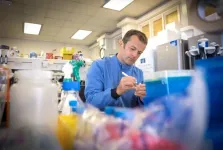(Press-News.org) Genome wide association studies (GWAS) have identified hundreds of genome regions containing thousands of genetic variants associated with asthma, but it’s still not clear which variants have an actual causal link to the disease. This “variant-to-function” gap is one of the biggest challenges to the usefulness of these genomic studies and has motivated researchers to develop new tools to make sense of GWAS results.
A new study by researchers from the University of Chicago combines genetic data and improved computational tools to look more closely at GWAS results for both adult-onset and childhood-onset asthma. The research identified many genetic variants with a high likelihood of having a causal effect on both types of asthma, paving the way for further studies to target the genes connected to these variants as potential treatments.
The study, published in Genome Medicine, also found significant differences in the sets of genes that could be linked to adult-onset and childhood-onset asthma, with relatively little overlap between the two.
“The real uniqueness of our study is that the differences between childhood- and adult-onset asthma were evident at every level that we looked at,” said Carole Ober, PhD, the Blum-Riese Distinguished Service Professor and Chair of Human Genetics at UChicago, and co-senior author of the paper. “You find out it's actually different variants that are contributing to asthma. Even when the GWAS locus looks the same, the genes functionally linked to these variants are also different. So, they're really quite different diseases.”
Fine-mapping causal variants
Researchers use GWAS to compare genome sequences from a large group of people with a disease to another set of sequences from healthy individuals. The differences identified in the disease group could point to genetic variants that increase risk for that disease and warrant further study. Most human diseases—including asthma—are not caused by a single genetic variant, however. Instead, they are the result of complex interactions among multiple genes, environmental factors, and host of other variables. As a result, GWAS often identifies too many variants across the genome to be of use without further refinement.
GWAS also identifies association only, not causality. In a typical genomic region, many variants are highly correlated with each other, due to a phenomenon called linkage disequilibrium. This is because DNA is passed from one generation to the next in entire blocks, not as individual variants. Therefore, variants nearby each other tend to be correlated. To make the problem more difficult, most of the genetic variants associated with diseases are located in non-coding regions of the genome, making their effects difficult to interpret.
In the new study, Ethan Zhong, a graduate student working with Ober and Xin He, PhD, Associate Professor of Human Genetics and another co-senior author of the paper, wanted to bridge the variant-to-function gap and find more concrete biological insights from different sets of asthma GWAS data. He worked with data from the UK Biobank, a large-scale biomedical database and research resource containing de-identified genetic data from nearly 500,000 people in the United Kingdom. Using a statistical method called “fine-mapping,” he was able to estimate the probability that a given genetic variant has a causal relationship to asthma.
The new estimates incorporated data on the accessibility of chromatin, the bundle of DNA and proteins that make up chromosomes. When a region is involved in regulating gene expression, the chromatin “opens” to become more accessible. The amount of open chromatin can be measured and used as an indicator of regulatory activity; when combined with statistical evidence, it builds an even stronger case that the variant is causally linked to asthma.
“The GWAS associations provide sets of variants associated with the disease,” Zhong said. “So, when those variants overlap with open chromatin regions in cell types that are relevant to asthma pathogenesis like lung epithelial cells, we think that they are more likely to be causal to these asthma phenotypes.”
Zhong also included data on expression quantitative trait loci (eQTLs), genetic variants associated with differences in gene expression, and chromatin interactions from blood and lung cell types, to link fine-mapped variants to their target genes. Using this information, he built a list of likely causal genes supported by genetic evidence.
Closing the gap
The fine-mapping analysis uncovered 21 independent sets of variants (called credible sets) for adult-onset asthma and 67 for childhood-onset, with only 16% shared between the two. Zhong also looked for cis-regulatory elements (CREs), short DNA sequences that control expression of nearby genes, that were linked to asthma and found 62 and 169 candidate genes for adult-onset and childhood-onset, respectively. More than 60% of these had open chromatin in different cell types, including many genes involved in immune and inflammatory responses.
The team selected six of the candidate CREs and tested them in bronchial epithelial cells to see if the variants had a regulatory effect; four of the six did, meaning their efforts are getting closer to the mark in the right kind of cells involved in asthma. The variant-to-function gap closes ever so slightly, opening the door to further studies of these candidate genes as potential targets for treatment.
The study was supported in part by a National Institutes of Health grant to discover genes in asthma and allergy, in collaboration with Marcelo Nobrega, MD, PhD, A.N. Pritzker Professor of Human Genetics at UChicago, Nathan Schoettler, MD, PhD, Assistant Professor of Medicine, and Anne Sperling, PhD, formerly of UChicago and now Professor of Medicine at the University of Virginia.
Additional authors include Robert Mitchell, Christine Billstrand, Emma Thompson, Noboru J. Sakabe, Ivy Aneas, Isabella M. Salamone, and Jing Gu.
END
Research fine tunes tools used to search for genetic causes of asthma
New study from UChicago combines genetic data and new computational tools to identify likely genetic variants that cause childhood- and adult-onset asthma.
2025-04-10
ELSE PRESS RELEASES FROM THIS DATE:
Meditation and critical thinking are the ‘key to meaningful AI use’
2025-04-10
People should learn to meditate and hone their critical thinking skills as AI becomes more integrated into daily lives, an expert suggests.
Digital strategy expert Giulio Toscani has spoken with 150 AI experts across 50 countries to understand the challenges and opportunities around human interactions with artificial intelligence.
He argues in his new book, Augmented: prAIority to Enhance Human Judgment through Data and AI, that as humans operate largely unconsciously by design, they are inclined toward immediacy and instant rewards, often overlooking potential ...
Studies shows new class of antibiotic is effective in tackling MRSA
2025-04-10
The development of new antibiotics to treat superbugs and other bacterial infections is a global priority, with the rate of infections that cannot be treated with current antibiotics rising and presenting one of the biggest threats to human health.
In line with that, new research has shown a daily dose of epidermicin NI01 – an antibiotic compound developed by University of Plymouth spinout company Amprologix – is as effective at removing Methicillin-resistant Staphylococcus aureus (MRSA) as the current standard of care.
The results were achieved through a robust skin MRSA infection model, and those behind the research say it justifies ...
Certain nasal bacteria may boost the risk for COVID-19 infection, study finds
2025-04-10
WASHINGTON (April 9, 2025) — A new study from researchers at the George Washington University has found that certain bacteria living in the nose may influence how likely someone is to get a COVID-19 infection. Published in EBioMedicine, the research reveals that certain types of nasal bacteria can affect the levels of key proteins the virus needs to enter human cells, offering new insight into why some people are more vulnerable to COVID-19 than others.
“We’ve known that the virus SARS-CoV-2 enters the body through the respiratory tract, with the nose being a key entry point. What’s new—and surprising—is that bacteria in our noses ...
Europe's population is adapting better to cold than to heat
2025-04-09
A study led by the Barcelona Institute for Global Health (ISGlobal), a centre supported by the "la Caixa" Foundation, has shown that Europe has adapted better to low temperatures than to high temperatures over the last two decades. The research, carried out in collaboration with the Barcelona Supercomputing Centre (BSC) and published in The Lancet Planetary Health, shows that there has been a significant decrease in cold-related mortality risk in recent years compared to the first decade of the 2000s. There has also been a reduction in the risk of heat-related ...
Ancient tools from a South African cave reveal connections between prehistoric people
2025-04-09
In a cave overlooking the ocean on the southern coast of South Africa, archaeologists discovered thousands of stone tools, created by ancient humans roughly 20,000 years ago. By examining tiny details in the chipped edges of the blades and stones, archaeologists are able to tell how the tools were made. In a new study published in the Journal of Paleolithic Archaeology, researchers analyzed these stone tools and discussed how the different techniques used to make them hint at the ways that prehistoric people traveled, interacted, and shared their craft.
“This is an important insight into how people who lived in this region ...
World’s first birth following conception with a fully automated remotely operated ICSI system
2025-04-09
10 April 2025: The world’s first baby has been born following conception with a fully automated, digitally controlled intracytoplasmic sperm injection (ICSI) system. ICSI, developed and adopted into widespread use in the 1990s and now a routine method of assisted conception, achieves fertilisation by injecting a single sperm cell into the centre of a mature egg.
The details are reported today in the peer-review medical journal Reproductive Biomedicine Online.(1) The automated system was described and developed by a multidisciplinary team of specialists from Conceivable ...
Girls’ education projects succeed when whole communities ‘live the change’ and carry it forward
2025-04-09
Education projects supporting marginalised girls in lower-income countries are more likely to achieve lasting transformations when they mobilise young women and their communities as “agents of change”, a new report indicates.
The recommendation comes from the latest evaluation of the Girls’ Education Challenge: a UK Government-supported initiative which has funded projects reaching more than 1.6 million girls. The University of Cambridge-led study finds that these projects initiated “virtuous cycles” of change – particularly by rooting themselves in communities and empowering young women to lead the way.
In ...
European bird declines linked to range of climatic conditions experienced
2025-04-09
New research suggests conservation efforts could more effectively identify and protect bird species at greatest risk from climate change by better understanding the range of specific conditions they need to thrive.
The study, led by the University of East Anglia (UEA), examined the relationship between the extent of the climatic conditions that species tolerate and in which populations can survive - known as climatic niche breadth - and their likelihood of declining in response to climate change.
For species inhabiting a similar area of geographic space, those able to tolerate ...
'Hidden galaxies' could be smoking gun in universe riddle
2025-04-09
Astronomers have peered back in time to find what looks like a population of 'hidden' galaxies that could hold the key to unlocking some of the universe's secrets.
If their existence is confirmed it would "effectively break current models of galaxy numbers and evolution".
The possible galaxies may also provide the missing piece of the puzzle for the energy generation in the universe in infrared light.
That's because their combined light would be enough to top-up the energy budget of the universe to the maximum we observe, effectively ...
Love songs in the sand: researchers listen in to Fiddler crab courtship
2025-04-09
UNDER EMBARGO UNTIL 00:01 BST THURSDAY 10 APRIL / 19:01 ET WEDNESDAY 9 APRIL 2025
For the first time, a study led by University of Oxford researchers has ‘listened in’ to the fascinating courtship displays of Fiddler crabs using geophones. The findings, published today in the Journal of Experimental Biology, provide new insights into how the animals communicate effectively on the noisy seashore.
For male fiddler crabs, vibrational signals are a crucial part of their courtship routines – produced by drumming the ground using their oversized claw, ...
LAST 30 PRESS RELEASES:
CHANGE-seq-BE finds off-target changes in the genome from base editors
The Journal of Nuclear Medicine Ahead-of-Print Tip Sheet: January 2, 2026
Delayed or absent first dose of measles, mumps, and rubella vaccination
Trends in US preterm birth rates by household income and race and ethnicity
Study identifies potential biomarker linked to progression and brain inflammation in multiple sclerosis
Many mothers in Norway do not show up for postnatal check-ups
Researchers want to find out why quick clay is so unstable
Superradiant spins show teamwork at the quantum scale
Cleveland Clinic Research links tumor bacteria to immunotherapy resistance in head and neck cancer
First Editorial of 2026: Resisting AI slop
Joint ground- and space-based observations reveal Saturn-mass rogue planet
Inheritable genetic variant offers protection against blood cancer risk and progression
Pigs settled Pacific islands alongside early human voyagers
A Coral reef’s daily pulse reshapes microbes in surrounding waters
EAST Tokamak experiments exceed plasma density limit, offering new approach to fusion ignition
Groundbreaking discovery reveals Africa’s oldest cremation pyre and complex ritual practices
First breathing ‘lung-on-chip’ developed using genetically identical cells
How people moved pigs across the Pacific
Interaction of climate change and human activity and its impact on plant diversity in Qinghai-Tibet plateau
From addressing uncertainty to national strategy: an interpretation of Professor Lim Siong Guan’s views
Clinical trials on AI language model use in digestive healthcare
Scientists improve robotic visual–inertial trajectory localization accuracy using cross-modal interaction and selection techniques
Correlation between cancer cachexia and immune-related adverse events in HCC
Human adipose tissue: a new source for functional organoids
Metro lines double as freight highways during off-peak hours, Beijing study shows
Biomedical functions and applications of nanomaterials in tumor diagnosis and treatment: perspectives from ophthalmic oncology
3D imaging unveils how passivation improves perovskite solar cell performance
Enriching framework Al sites in 8-membered rings of Cu-SSZ-39 zeolite to enhance low-temperature ammonia selective catalytic reduction performance
AI-powered RNA drug development: a new frontier in therapeutics
Decoupling the HOR enhancement on PtRu: Dynamically matching interfacial water to reaction coordinates
[Press-News.org] Research fine tunes tools used to search for genetic causes of asthmaNew study from UChicago combines genetic data and new computational tools to identify likely genetic variants that cause childhood- and adult-onset asthma.





